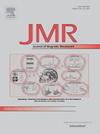Leveraging AlphaFold2 and residual dipolar couplings for side-chain methyl group assignment: A case study with S. cerevisiae Xrs2
IF 1.9
3区 化学
Q3 BIOCHEMICAL RESEARCH METHODS
引用次数: 0
Abstract
Side-chain methyl group NMR spectroscopy provides invaluable insights into macromolecular structure, dynamics, and function, particularly for large biomolecular complexes. Accurate assignment of methyl group resonances in two-dimensional spectra is essential for structural and dynamics studies. Traditional methyl group assignment strategies rely on either transferring assignments from backbone resonance data or NOESY data and high-resolution experimental structures; however, these methods are often limited by molecular size or availability of structural information, respectively. Here, we describe the use of AlphaFold2 structural models as a basis for the manual, distance-based assignment of side-chain methyl group resonances in the folded domains of S. cerevisiae Xrs2. While AlphaFold2 models facilitated initial assignments for the methyl resonances, inaccuracies in the side-chain coordinates highlighted the need for improved structural models. By generating >500 ColabFold-derived models and filtering with methyl residual dipolar couplings (RDCs), we identified structural models with superior agreement to experimental data. These refined models enabled additional methyl group assignments while suggesting an iterative approach to simultaneously improve structure prediction and resonance assignment. Our findings outline a workflow that integrates machine learning-based structural predictions with experimental NMR data, offering a pathway for advancing methyl group assignment in systems lacking high-resolution experimental structures.

利用AlphaFold2和剩余偶极偶联进行侧链甲基分配:酿酒葡萄球菌Xrs2的案例研究
侧链甲基核磁共振波谱为大分子结构,动力学和功能提供了宝贵的见解,特别是对于大型生物分子复合物。二维光谱中甲基共振的准确分配对于结构和动力学研究至关重要。传统的甲基分配策略依赖于从骨干共振数据或NOESY数据和高分辨率实验结构中转移分配;然而,这些方法往往分别受到分子大小或结构信息可用性的限制。在这里,我们描述了AlphaFold2结构模型的使用,作为S. cerevisiae Xrs2折叠结构域侧链甲基共振的手动、基于距离的分配的基础。虽然AlphaFold2模型有助于甲基共振的初始分配,但侧链坐标的不准确性突出了改进结构模型的必要性。通过生成>;500个colabfold衍生模型并使用甲基残差偶极耦合(rdc)进行滤波,我们确定了与实验数据非常吻合的结构模型。这些改进的模型可以实现额外的甲基分配,同时提出迭代方法来同时改进结构预测和共振分配。我们的研究结果概述了一个将基于机器学习的结构预测与实验NMR数据相结合的工作流程,为在缺乏高分辨率实验结构的系统中推进甲基分配提供了一条途径。
本文章由计算机程序翻译,如有差异,请以英文原文为准。
求助全文
约1分钟内获得全文
求助全文
来源期刊
CiteScore
3.80
自引率
13.60%
发文量
150
审稿时长
69 days
期刊介绍:
The Journal of Magnetic Resonance presents original technical and scientific papers in all aspects of magnetic resonance, including nuclear magnetic resonance spectroscopy (NMR) of solids and liquids, electron spin/paramagnetic resonance (EPR), in vivo magnetic resonance imaging (MRI) and spectroscopy (MRS), nuclear quadrupole resonance (NQR) and magnetic resonance phenomena at nearly zero fields or in combination with optics. The Journal''s main aims include deepening the physical principles underlying all these spectroscopies, publishing significant theoretical and experimental results leading to spectral and spatial progress in these areas, and opening new MR-based applications in chemistry, biology and medicine. The Journal also seeks descriptions of novel apparatuses, new experimental protocols, and new procedures of data analysis and interpretation - including computational and quantum-mechanical methods - capable of advancing MR spectroscopy and imaging.

 求助内容:
求助内容: 应助结果提醒方式:
应助结果提醒方式:


